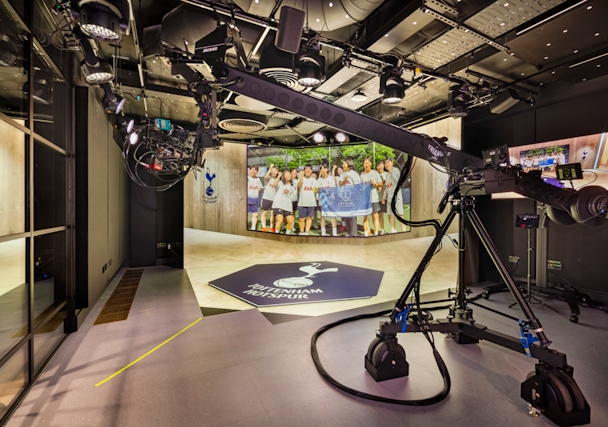Is this the future of football media? Behind the scenes at Tottenham Hotspur’s Clubhouse
From its new state-of-the-art media center at the Hotspur Way training ground, the Premier League club is producing increasingly sophisticated content for fans and brands. The Drum followed in the footsteps of Son Heung-min and co to take a look around.

The Clubhouse includes a XR studio - a European football club first / Tottenham The Clubhouse
Walking through the well-manicured football pitches, past locker rooms and gyms, you would be surprised to find a state-of-the-art production studio in the center of a Premier League training ground.
But that’s exactly what we were introduced to when The Drum was given rare access to Tottenham Hotspur’s recently opened media facility, The Clubhouse, which houses three studios, a gallery, edit suites and production offices all set against the backdrop of the first team’s training pitch.
The Clubhouse marks a significant development in the evolution of football clubs becoming mature media businesses. As Tottenham Hotspur's media director, Pierre-Olivier Bouche, proclaims to The Drum: “We are in the entertainment industry.”
After the ultra-modern Tottenham Stadium was opened in 2019, there was an internal discussion that its media business should match the quality of the ground. “Tottenham has been very innovative with the stadium and how it plays but were we that innovative when it comes to content creation?” Bouche says.
The idea for The Clubhouse was born and the physical building followed this year. As you would expect, the production unit makes team-related content for Tottenham’s club channels, including Spursplay, TikTok, YouTube, Twitter, Facebook, Instagram and Whatsapp as well as its match day program. But perhaps more interesting is its branded content offering which, leveraging the new facilities, means Spurs can now handle everything for its partners from idea development to production, editing and distribution.
The club employs video producers, writers, motion graphics specialists and editors, who share an office situated above the studios.
Bouche, who came from the broadcasting world having spent 12 years at Eurosport before taking the job at Spurs, says he’s seen first-hand how brands have adjusted their way of partnering with sports teams.
“The evolution of this started with a brand saying: ‘We have an ad, and we want you to play it because you have a big audience, play it, and it will work.’ But in reality, it doesn’t work,” he says. “There has been a big evolution, where now the brands ask us to be first part the brainstorming and then the second step is that we are now developing and producing for them – production, location and resources.”
Want to go deeper? Ask The Drum
It has taken a while for brands to want to work that way, he says, acknowledging that it can be simpler to work with agencies. “But now they just look at the numbers, engagement and so on, and they know we are here to create great content for our fans,” Bouche says.
“For many years we saw content coming from brands that knew didn’t work, and if it does not work, fans are not happy, the brand is not happy, and we aren’t happy as well.”
Examples include a carpool video format for Ineos that had first-team players interviewing each other while driving around the Hertfordshire countryside that surrounds the training ground. Another high-profile project with EA Sports, for its FC 2024 game, filmed players going head-to-head on the virtual pitch having just finished training on the real one.
Advertisement
Along with the more high-end formats, the proximity to the players has greatly improved the ease at which they can film quick content, including TikToks jumping on the pie-in-the-face viral trend, playing games of chess or recording ‘what I eat in a day’ videos.
“Fans want more and more behind-the-scenes authentic content. The storytelling is different, it now needs to be developed by producers who work every day in football or in sport, who understand the evolution of the industry,” he adds.
'Player access is everything to brands’
There was debate about whether to build the media center at the stadium, which is more common practice for other football clubs, but easier access to the players was an essential requirement. “Brands need access to the players but then they need a location, and this is where we are in charge and we will produce everything,” Bouche says.
Advertisement
The studio is connected to the first team’s suite in the training ground allowing players to come off the pitch, jump in the shower and then hop straight into the studio to film a TikTok or record a podcast.
“We need to make it easy, not only for ourselves but also for the players and their busy schedules. We need to maximize that time that the players are giving us anyway, and that’s where big studios really come into their own,” Bouche says.
The main studio has three distinct sets: one a large sofa that overlooks the pitch, another with chairs positioned in front of a TV to film watch-party-style recordings and then a kitchen set which is often used for food and nutrition content.
Ready-to-go cameras and lighting are built into the joinery and controlled from one system. It was important to the club that the tech has a low barrier to entry to help train younger producers.
Suggested newsletters for you
“One of the core reasons for building the studio in this way was to improve efficiencies, make sure that we were very quick at producing content,” Bouche says. “If it’s something really, really small, we don’t want to be setting up for hours and hours and hours and hours, because it’s just not a good use of everyone’s time.”
There is also an Extended Reality (XR) studio – a first for a European football club – which uses tech typically seen in broadcast studios such as Sky or the BBC. The list of possible use cases for this technology is fairly endless and Bouche admits it can be a little overwhelming for brands, so the team has created templates to help guide marketers. One recent example was striker Dominic Solanke’s transfer announcement video, which blended real life and anime, which is a passion of his. Bouche suggests that the studio has been the biggest intrigue of other clubs.
“Through the Clubhouse, we are now leading the way in European football when it comes to creating exciting formats for our fans and branded content production for our partners,” Bouche says. “It is opening the doors to endless opportunities for the Club to grow its brand and maximize revenues in an increasingly competitive industry.”
